#Imperial Japanese Navy Air Service
Text
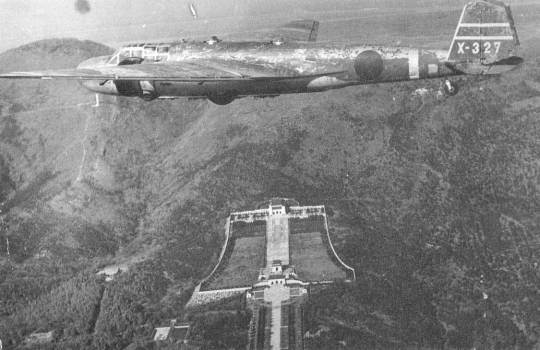
Bombardier Mitsubishi G3M Type 96 du Kisarazu Air Group au-dessus du Mausolée de Sun Yat-sen – Guerre sino-japonaise – Nankin – Chine – 1938
#WWII#guerre sino-japonaise#sino-japanese war#seconde guerre sino-japanaise#second sino-japanese war#marine impériale japonaise#imperial japanese navy#ijnas#imperial japanese navy air service#aviation militaire#military aviation#bombardier#bomber#bombardier moyen#medium bomber#mitsubishi g3m#mausolée de sun yat-sen#sun yat-sen mausoleum#nankin#nanjing#chine#china#1938
10 notes
·
View notes
Photo
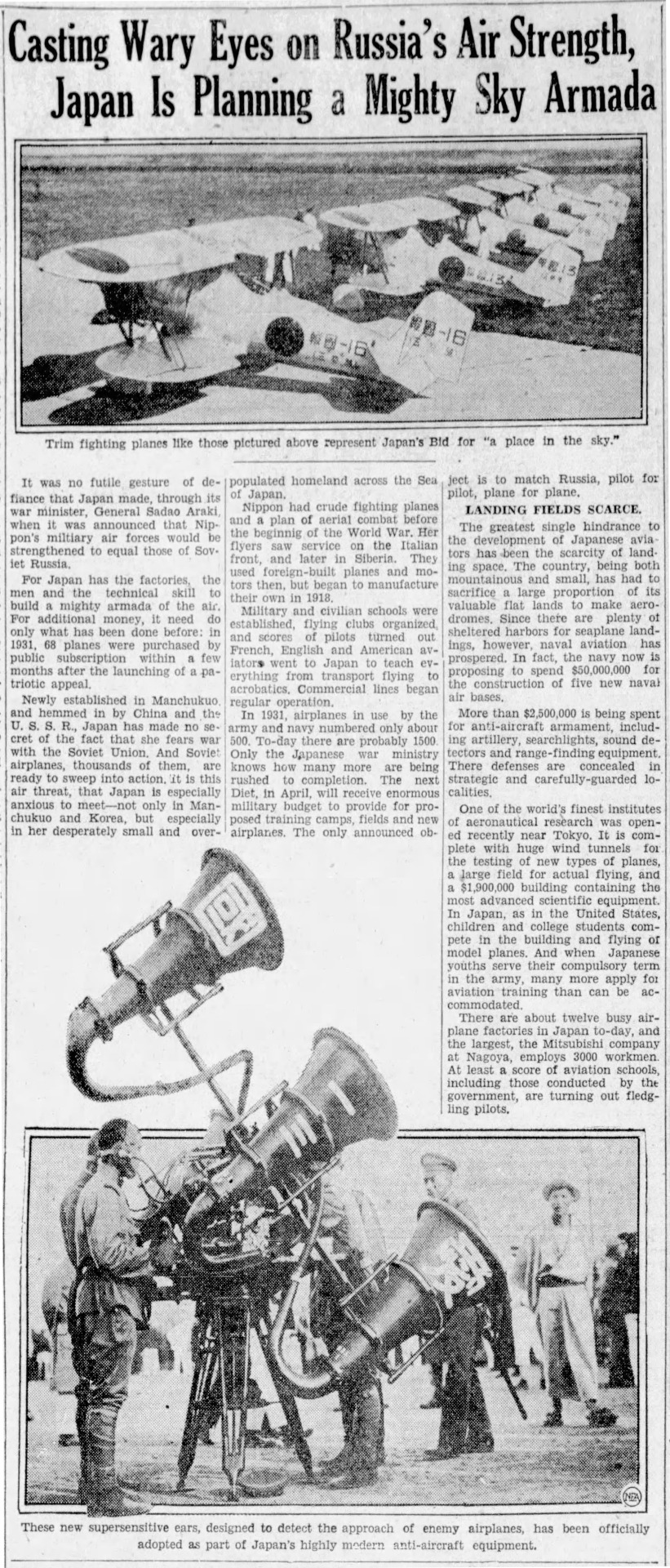
“Casting Wary Eyes on Russia’s Air Strength Japan Is Planning a Mighty Sky Armada,” Brantford Expositor. February 7, 1933. Page 3.
----
Top image: Trim fighting planes like those pictured above represent Japan's bid for "a place in the sky”
---
It was no futile gesture of defiance that Japan made through its war minister, General Sadao Araki, when it was announced that Nippon's military air forces would be strengthened to equal those of Soviet Russia.
For Japan has the factories, the men, and the technical skill to build a mighty armada of the air. For additional money, it needs do only what has been done before: in 1931, 68 planes were purchased by public subscription within a few months after the launching of a patriotic appeal.
Newly established in Manchukuo and hemmed In by China and the U.S.S.R., Japan has made no secret of the fact that she fears war with the Soviet Union. And Soviet airplanes, thousands of them, are ready to sweep into action, it is this air threat that Japan is especially anxious to meet— not only in Manchukuo and Korea, but especially In her desperately small and over-populated homeland across the Sea of Japan.
Nippon had crude fighting planes and a plan of aerial combat before the beglnnlg of the World War. Her flyers saw service on the Italian front and later in Siberia. They used foreign-built planes and motors then but began to manufacture their own in 1918.
Military and civilian schools were established, flying clubs organized, and scores of pilots turned out. French, English, and American aviators went to Japan to teach everything from transport flying to acrobatics. Commercial lines began regular operation.
In 1931, airplanes in use by the army and navy numbered only about 500. To-day there are probably 1500. Only the Japanese war ministry knows how many more are being rushed to completion. The next Diet in April will receive enormous military budget to provide for pro-posed training camps fields and new airplanes. The only announced object is to match Russia pilot for pilot, plane for plane.
LANDING HELDS SCARCE
The greatest single hindrance to the development of Japanese aviators has been the scarcity of landing space. The country, being both mountainous and small, has had to sacrifice a large proportion of its valuable flat lands to make aerodromes. Since there are plenty of sheltered harbors for seaplane landings, however, naval aviation has prospered. In fact, the navy now is proposing to spend $50,000,000 for the construction of five new naval air bases.
More than $2,500,000 being spent for anti-aircraft armament including artillery searchlights, sound detectors, and range-finding equipment. There defenses are concealed in strategic and carefully-guarded localities.
One of the world's finest institutes of aeronautical research was opened recently near Tokyo. It is complete with huge wind tunnels for the testing of new types of planes, a large field for actual flying, and a $1,900,000 building, containing the most advanced scientific equipment in Japan as in the United States, children and college students compete in the building and flying or model planes. And when Japanese youths serve their compulsory term in the army, many more apply for aviation training than can be accommodated.
There are about twelve busy airplane factories in Japan to-day and the largest the Mitsubishi company at Nagoya employs 3000 workmen At least a score of aviation schools including those conducted by the government are tinning out fledgling pilots.
----
Bottom image: These new super-sensitive ears designed to detect the approach of enemy airplanes has been officially adopted as part of Japan's highly modern anti-aircraft equipment.
#imperial japanese army air force#大日本帝國陸軍航空部隊#imperial japanese navy air service#大日本帝國海軍航空隊#imperial japan#imperial japanese army#naval aviation#air base#japanese imperialism#air force#manchukuo#manchurian incident#air defences#air raid precautions#air training#empire of japan
6 notes
·
View notes
Text
On the 29th of June, thirteen years ago, Girls' Generation released their second EP, Tell Me Your Wish (Genie).
Controversy erupted over the mini-album cover after netizens claimed the fighter plane was a direct replica of Japan’s A6M Zero fighter planes, which was operated by the Imperial Japanese Navy Air Service in World War 2. Bloggers also complained about the use of an eagle emblem on Girls' Generation's hats that resembled the Parteiadler of the NSDAP. Due to the controversy, SM Entertainment postponed the mini-album release date, which was to be released on June 25, 2009, to June 29, 2009. The plane on the cover was replaced with the South Korean T-50 Golden Eagle, and the Nazi emblems on the girl's uniforms were removed.

Just like its predecessor Gee, the title track proved to be a big hit, as it conquered various music sites like Melon, Dosirak, MNet, Bugs and it was No.1 on the weekly charts and SKT ringtone weekly charts of the first week of July. It sold over 3M copies, making it their second smash hit in a row after genie.
youtube
The mini-album sold an estimated 50,000+ copies in its first week after released (almost double the numbers from the first-week sales of Gee), an unusual feat for any Korean girl group. The albums went to sell over 200,000 as of 2010.
#Girls' Generation#Taeyeon#Yoona#Tiffany#Jessica#Seohyun#Sooyoung#Hyoyeon#Yuri#Sunny#Tell Me Your Wish (Genie)#Tell Me Your Wish#Genie#K pop#Youtube
9 notes
·
View notes
Text
Ronnie Bell Following
Kawanishi H6K Mavis
Mechanics of 3219 Servicing Command of Royal Air Force (RAF), check the engines of a Japanese Kawanishi H6K 'Mavis' flying boat at Sourabaya Java, in preparation for an air test flight. Of interest are the markings added by Indonesian nationalists and the fact that an additional band of blue has been added to the fuselage marking by the Dutch.
Date January 1946.
The Kawanishi H6K was an Imperial Japanese Navy flying boat produced by the Kawanishi Aircraft Company and used during World War II for maritime patrol duties. The Allied reporting name for the type was Mavis; the Navy designation was "Type 97 Large Flying Boat, The aircraft was designed in response to a Navy requirement of 1934 for a long range flying boat and incorporated knowledge gleaned by a Kawanishi team that had visited the Short Brothers factory in the UK, at that time one of the world's leading producers of flying boats, and from building the Kawanishi H3K, a license-built, enlarged version of the Short Rangoon. The Type S, as Kawanishi called it, was a large, four-engine monoplane with twin tails, and a hull suspended beneath the parasol wing by a network of struts. Three prototypes were constructed, each one making gradual refinements to the machine's handling both in the water and in the air, and finally fitting more powerful engines. The first of these flew on 14 July 1936 and was originally designated Navy Type 97 Flying Boat, later H6K. Eventually, 217 would be built , Operational history H6Ks were deployed from 1938 onwards, first seeing service in the Sino-Japanese War and were in widespread use by the time the Pacific War full-scale erupted, in 1942. At that time of the war, four kokutai operated a total of 66 H6K4s.
The type had some success over South East Asia and the South West Pacific. H6Ks had excellent endurance, being able to undertake 24-hour patrols, and was often used for long-range reconnaissance and bombing missions. From bases in the Dutch East Indies, they were able to undertake missions over a large portion of Australia.
However, the H6K became vulnerable to a newer generation of heavier armed and faster fighters. It continued in service throughout the war, in areas where the risk of interception was low. In front-line service, it was replaced by the Kawanishi H8K.
Variants
A H6K2-L Navy Transport Flying Boat Type 97H6K1
Evaluation prototypes with four Nakajima Hikari 2 engines, 4 built.
H6K1 (Navy Flying Boat Type 97 Model 1)
Prototypes with 746 kW 1,000 hp Mitsubishi Kinsei 43 Engines, 3 converted from the original H6K1 prototypes.
H6K2 Model 11
First production model. Includes two H6K2-L officer transport modification, 10 built.
H6K2-L (Navy Transport Flying Boat Type 97)
Unarmed transport version of H6K2 powered by Mitsubishi Kinsei 43 engines, 16 built.
H6K3 Model 21
Modified transport version of H6K2 for VIPs and high-ranking officers, 2 built.
H6K4 Model 22
Major production version, modified H6K2 with revised weapons, some with 694 kW (930 hp) Mitsubishi Kinsei 46 engines. Fuel capacity increased from 7,764 L (1,708 Imp gal) to 13,410 L (2,950 Imp gal). Includes two H6K4-L transport versions, 100 to 127 (if other numbers are all correct) built.
H6K4-L
Transport version of H6K4, similar to H6K2-L, but with Mitsubishi Kinsei 46 engines, 20 built and another two converted from the H6K4.
H6K5 Model 23
Fitted with 969 kW (1,300 hp) Mitsubishi Kinsei 51 or 53 engines and new upper turret replacing the open position, 36 built.
Via Flickr
8 notes
·
View notes
Note
I know alternate history is not your field but change would we see if the imperial Japanese airforce was created in 1928, I ask because there were proposals for it that time but the army navy big wigs shot it down be cause they didn't want to lose there designs.
I like alternate histories and pondering what ifs but an Imperial Japanese Air Force is kinda out of my wheel house.
I imagine it would have gone just as well as the Navy and Army as far as cooperation and stretched their limited resources even more than what we see in our timeline. The Air Force would probably end up with equipment they should have had in the first place, like tanks and aircraft carriers like how the Navy designed and built their own tanks and the Army designed and built their own carriers because the two services couldn't cooperate to save their soldiers lives. If anything, the war in the Pacific might have ended sooner.
There's a reason why it doesn't exist in that time period and it has everything to do with the Imperial Japanese military culture at that time.
So for your idea to work, the Army and Navy would need to have settled their interservice rivalry to allow an Air Force and then it's hard to say from there. But I would imagine WWII might have lasted longer and the Soviets would have gotten more involved after Germany was defeated, leading to a North and South Japan during the Cold War. So anime might or might not exist or at the very least be different.
Thanks for the ask anon.
#Ask#Anon#Alternate History#Alternative Universe#AH#AU#Imperial Japan#Imperial Japanese Navy#Imperial Japanese Army#my post
5 notes
·
View notes
Text
1 note
·
View note
Text

1 April 1939. First flight of Mitsubishi A6M1 Zero (Zeke) piloted by Chief Test Pilot Katsuzo Shima at Kagamigahara aerodrome. Imperial Japanese Navy Air Service long range fighter powered by a 780 hp Mitsubishi Zuisei 13 engine with a two-blade propeller.


0 notes
Note
FAG
The attack on Pearl Harbor was a surprise military strike by the Imperial Japanese Navy Air Service upon the United States against the American naval base at Pearl Harbor in Honolulu, Hawaii, just before 8:00 a.m. on Sunday, December 7, 1941. the Japanese military launched a surprise attack on the United States Naval Base at Pearl Harbor, Hawaii. Since early 1941 the U.S. had been supplying Great Britain in its fight against the Nazis. It had also been pressuring Japan to halt its military expansion in Asia and the Pacific. At about 8 a.m., Japanese planes filled the sky over Pearl Harbor. Bombs and bullets rained onto the vessels moored below. At 8:10, a 1,800-pound bomb smashed through the deck of the battleship USS Arizona and landed in her forward ammunition magazine. The ship exploded and sank with more than 1,000 men trapped inside. After two hours of bombing, 21 U.S. ships were sunk or damaged, 188 U.S. aircraft were destroyed, and 2,403 people were killed. All of this happened while the U.S. and Japan were officially engaging in diplomatic negotiations for possible peace in Asia.
YOU DID NOT
0 notes
Link
0 notes
Photo
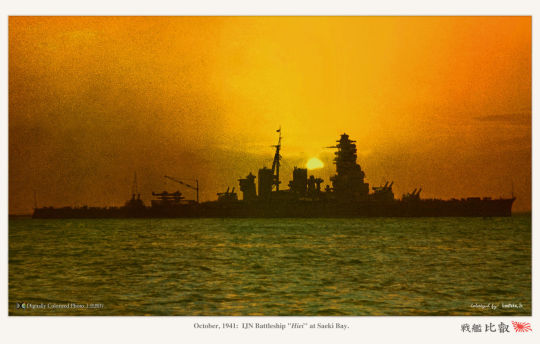
Croiseur de bataille Hiei de la Marine Impériale japonaise – Baie de Saeki – Japon – Octobre 1941
©Colorisation par...?
#WWII#Marine impériale japonaise#Imperial Japanese Navy Air Service#IJN#Marine militaire#Military navy#Navire de guerre#Warship#Croiseur de bataille#Battlecruiser#Classe Kongo#Kongo class#Hiei#Baie de Saeki#Saeki Bay#Japon#Japan#10/1941#1941
4 notes
·
View notes
Photo

“Jap Fliers Captured in Phillipines,” Sault Star. April 2, Page 1.
----
These two Japanese fliers were shot down and captured during an air raid on Manila during the early days of the war in the Philippines. This photo, released in Washington, is one of the first to reach the U.S. from the islands since the Japs struck their treacherous blow in the Pacific.
#philippines campaign#manila#air raid#shot down#フィリピンの戦い#imperial japanese navy air service#大日本帝國海軍航空隊#pacific war#world war II#prisoners of war#imperial japanese navy#empire of japan
3 notes
·
View notes
Text
Events 8.9 (after 1900)
1902 – Edward VII and Alexandra of Denmark are crowned King and Queen of the United Kingdom of Great Britain and Ireland.[6]
1907 – The first Boy Scout encampment concludes at Brownsea Island in southern England.
1925 – A train robbery takes place in Kakori, near Lucknow, India, by the Indian independence revolutionaries, against British government.
1936 – Summer Olympics: Jesse Owens wins his fourth gold medal at the games.
1942 – World War II: Battle of Savo Island: Allied naval forces protecting their amphibious forces during the initial stages of the Battle of Guadalcanal are surprised and defeated by an Imperial Japanese Navy cruiser force.
1944 – The United States Forest Service and the Wartime Advertising Council release posters featuring Smokey Bear for the first time.
1944 – World War II: Continuation War: The Vyborg–Petrozavodsk Offensive, the largest offensive launched by Soviet Union against Finland during the Second World War, ends to a strategic stalemate. Both Finnish and Soviet troops at the Finnish front dug to defensive positions, and the front remains stable until the end of the war.
1945 – World War II: Nagasaki is devastated when an atomic bomb, Fat Man, is dropped by the United States B-29 Bockscar. Thirty-five thousand people are killed outright, including 23,200–28,200 Japanese war workers, 2,000 Korean forced workers, and 150 Japanese soldiers.
1945 – The Red Army invades Japanese-occupied Manchuria.
1960 – South Kasai secedes from the Congo.
1965 – Singapore is expelled from Malaysia and becomes the only country to date to gain independence unwillingly.
1969 – Tate–LaBianca murders: Followers of Charles Manson murder pregnant actress Sharon Tate (wife of Roman Polanski), coffee heiress Abigail Folger, Polish actor Wojciech Frykowski, men's hairstylist Jay Sebring and recent high-school graduate Steven Parent.
1970 – LANSA Flight 502 crashes after takeoff from Alejandro Velasco Astete International Airport in Cusco, Peru, killing 99 of the 100 people on board, as well as two people on the ground.
1971 – The Troubles: In Northern Ireland, the British authorities launch Operation Demetrius. The operation involves the mass arrest and internment without trial of individuals suspected of being affiliated with the Irish Republican Army (PIRA). Mass riots follow, and thousands of people flee or are forced out of their homes.
1973 – Mars 7 is launched from the USSR.
1974 – As a direct result of the Watergate scandal, Richard Nixon becomes the first President of the United States to resign from office. Vice President Gerald Ford becomes president.
1991 – The Italian prosecuting magistrate Antonino Scopelliti is murdered by the 'Ndrangheta on behalf of the Sicilian Mafia while preparing the government's case in the final appeal of the Maxi Trial.
1993 – The Liberal Democratic Party of Japan loses a 38-year hold on national leadership.
1995 – Aviateca Flight 901 crashes into the San Vicente volcano in El Salvador, killing all 65 people on board.
1999 – Russian President Boris Yeltsin fires his Prime Minister, Sergei Stepashin, and for the fourth time fires his entire cabinet.
2006 – At least 21 suspected terrorists are arrested in the 2006 transatlantic aircraft plot that happened in the United Kingdom. The arrests are made in London, Birmingham, and High Wycombe in an overnight operation.
2007 – Air Moorea Flight 1121 crashes after takeoff from Moorea Airport in French Polynesia, killing all 20 people on board.
2012 – Shannon Eastin becomes the first woman to officiate an NFL game.
2013 – Gunmen open fire at a Sunni mosque in the city of Quetta killing at least ten people and injuring 30.
2014 – Michael Brown, an 18-year-old African American male in Ferguson, Missouri, is shot and killed by a Ferguson police officer after reportedly assaulting the officer and attempting to steal his weapon, sparking protests and unrest in the city.
2021 – The Tampere light rail officially starts operating.
1 note
·
View note
Photo
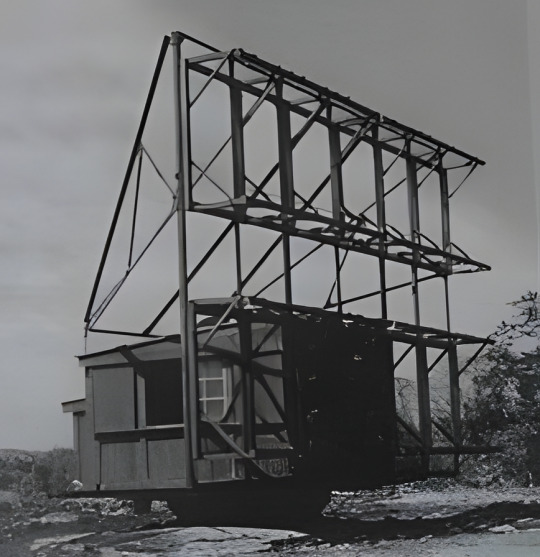
https://pacificeagles.net/11-go-air-search-radar/
11-Go Air Search Radar
A Japanese scientific delegation under Cdr Yoji Ito was sent to Germany in February 1941. Although the professional relationship between the Japanese and the Germans was far less cordial than that of the Americans and British, the Germans showed enough evidence of the development of radar for Ito to be shocked. The capabilities of both of their erstwhile ally and the British were evident to Ito and his team and were amply demonstrated by two radar-assisted victories enjoyed by the British in the spring of 1941 – the Battle of Cape Matapan, during which Royal Navy ships sank three cruisers and two destroyers in a night action, and the destruction of the Bismarck which was shadowed by radar-equipped cruisers. Fearing that their advantage in night-combat skills would disappear in the face of Allied technological superiority, the Japanese Navy began a program to produce their own radar designs to close the gap.
Technical assistance for the design of the Imperial Japanese Navy’s first radar was provided by national broadcaster NHK’s Technical Research Lab and the electronics firm NEC. A prototype set operating on 4.2m wavelength was built relatively quickly, followed by a 3m wavelength set in September 1941. In tests this prototype detected a medium bomber at 97km and a flight of three at 145km, performance that was comparable with early-model Allied air-search radar. Three firms were contracted to make components for the production models, designated Mark 1 (for land-based) Model 1 or 11-Go – these are often misnamed as Type 11 in English sources. These entered service remarkably quickly – the first was installed at Katsuura Lighthouse in November 1941.
A handful of 11-Go were produced during the first months of 1942, with the first overseas unit deployed to Rabaul in March. Another pair were deployed to Guadalcanal when the new airfield there was constructed. These were captured by the US Marines when they landed on the island in August 1942, and in the absence of their own radar marines of the 3rd Defense Battalion attempted to put one of the 11-Go into service without much success. One was later shipped to the Naval Research Laboratory where it underwent significant testing. Later still it was used to help train American aviators in the new field of “electronic warfare” helping them to recognise the distinctive nature of Japanese radar sets on their detection and warning gear.
Other 11-Go were deployed to Japanese-held island throughout 1942. Two were sent to Kiska in the Aleutians, where American ‘ferret’ aircraft detected their emissions. Others were deployed to Wake Island to help fend off the infrequent attacks launched by long-range bombers operating from Midway, as well as the Japanese Mandates (the Caroline and Marshall Islands) and the Bonin Islands, including Iwo Jima. Dozens were deployed in China and Japan, where they were frequently detected by B-29 crews on their receiving gear. In total around 30 11-Go sets were produced in several variants.
0 notes
Text
1976 – Mitsuo Fuchida

Mitsuo Fuchida (淵田 美津雄, Fuchida Mitsuo, 3 December 1902 – 30 May 1976) was a Japanese captain[1] in the Imperial Japanese Navy Air Service and a bomber observer in the Imperial Japanese Navy before and during World War II. He is perhaps best known for leading the first wave of air attacks on Pearl Harbor on 7 December 1941.
0 notes
Text
The H8K entered production in 1941 and first saw operational
use on the night of 4 March 1942 in a second raid on Pearl Harbor. Since the target lay out of range for the flying boats, this audacious plan involved a refuelling by submarine at French Frigate Shoals, some 550 miles north-west of Hawaii, en route. Two planes from the Yokohama Kokutai (Naval Air Corps) attempted to bomb Pearl Harbor, but, due baby hair clipper Manufacturers to poor visibility, did not accomplish any significant damage.H8K2s were used on a wide range of patrol, reconnaissance, bombing, and transport missions throughout the Pacific war. The H8K2 was given the Allied code name "Emily".Four aircraft survived until the end of the war. One of these, an H8K2, was captured by U.S. forces at the end of the war and was evaluated before being eventually returned to Japan in 1979. It was on display at Tokyo's Museum of Maritime Science until 2004, when it was moved to Kanoya Air Base in Kagoshima.The submerged remains of an H8K can be found off the west coast of Saipan, where it is a popular scuba diving attraction known erroneously as the "B-29", or the "Emily". Another wrecked H8K lies in Chuuk Lagoon, Chuuk, in Micronesia. This aircraft is located off the south-western end of Dublon Island.The Mitsubishi F1M (Allied reporting name "Pete") was a Japanese reconnaissance floatplane of World War II. It was the last biplane type of the Imperial Japanese Navy, with 1,118 built between 1936 and 1944. The Navy designation was "Type Zero Observation Seaplane", not to be confused with the Type Zero Carrier Fighter or the Type Zero Reconnaissance Seaplane.
The F1M1 was powered by the Nakajima Hikari MK1 radial engine, delivering 611 kW (820 hp), a maximum speed of 368 km/h (230 mph) and operating range of up to 1,072 km (670 mi) (when overloaded). It provided the Imperial Japanese Navy with a very versatile operations platform.Optionally armed with a maximum of three 7.7 mm (.303 in) machine guns (two fixed forward-firing and one flexible rear-firing) and two 60 kg (132 lb) bombs.The F1M was originally built as a catapult-launched reconnaissance float plane, specializing in gunnery spotting. However the "Pete" took on a number of local roles including area-defense fighter, convoy escort, bomber, anti-submarine, maritime patrol, rescue and transport. The type fought dogfights in the Aleutians, the Solomons and several other theaters. See also PT 34 sunk 9 April 1942 by "Petes".The Consolidated PBY Catalina was an American flying boat of the 1930s and 1940s produced by Consolidated Aircraft. It was one of the most widely used multi-role aircraft of World War II. PBYs served with every branch of the United States Armed Forces and in the air forces and navies of many other nations. In the United States Army Air Forces and later in the United States Air Force their designation was the OA-10, while Canadian-built PBYs were known as the Canso.During World War II, PBYs were used in anti-submarine warfare, patrol bombing, convoy escorts, search and rescue missions (especially air-sea rescue), and cargo transport. The PBY was the most successful aircraft of its kind; no other flying boat was produced in greater numbers. The last active military PBYs were not retired from service until the 1980s.
Even today, over 70 years after its first flight, the aircraft continues to fly as an airtanker in aerial firefighting operations all over the world.The initialism of "P.B.Y." was determined in accordance with the U.S. Navy aircraft designation system of 1922; PB representing "Patrol Bomber" and Y being the code used for the aircraft's manufacturer, Consolidated Aircraft.The PBY was originally designed to be a patrol bomber, an aircraft with a long operational range intended to locate and attack enemy transport ships at sea in order to compromise enemy supply lines.
0 notes
Text
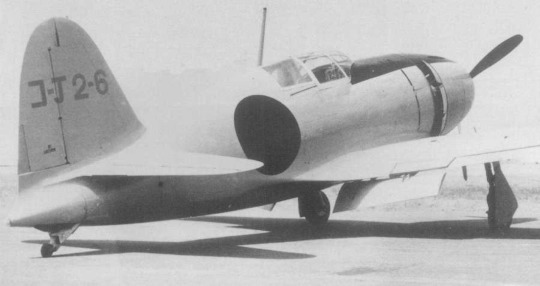
20 March 1942. First flight of the Mitsubishi J2M Raiden 'Jack'. Single-engine land-based fighter aircraft used by the Imperial Japanese Navy Air Service in WWII.
@ron_eisele via X
0 notes
